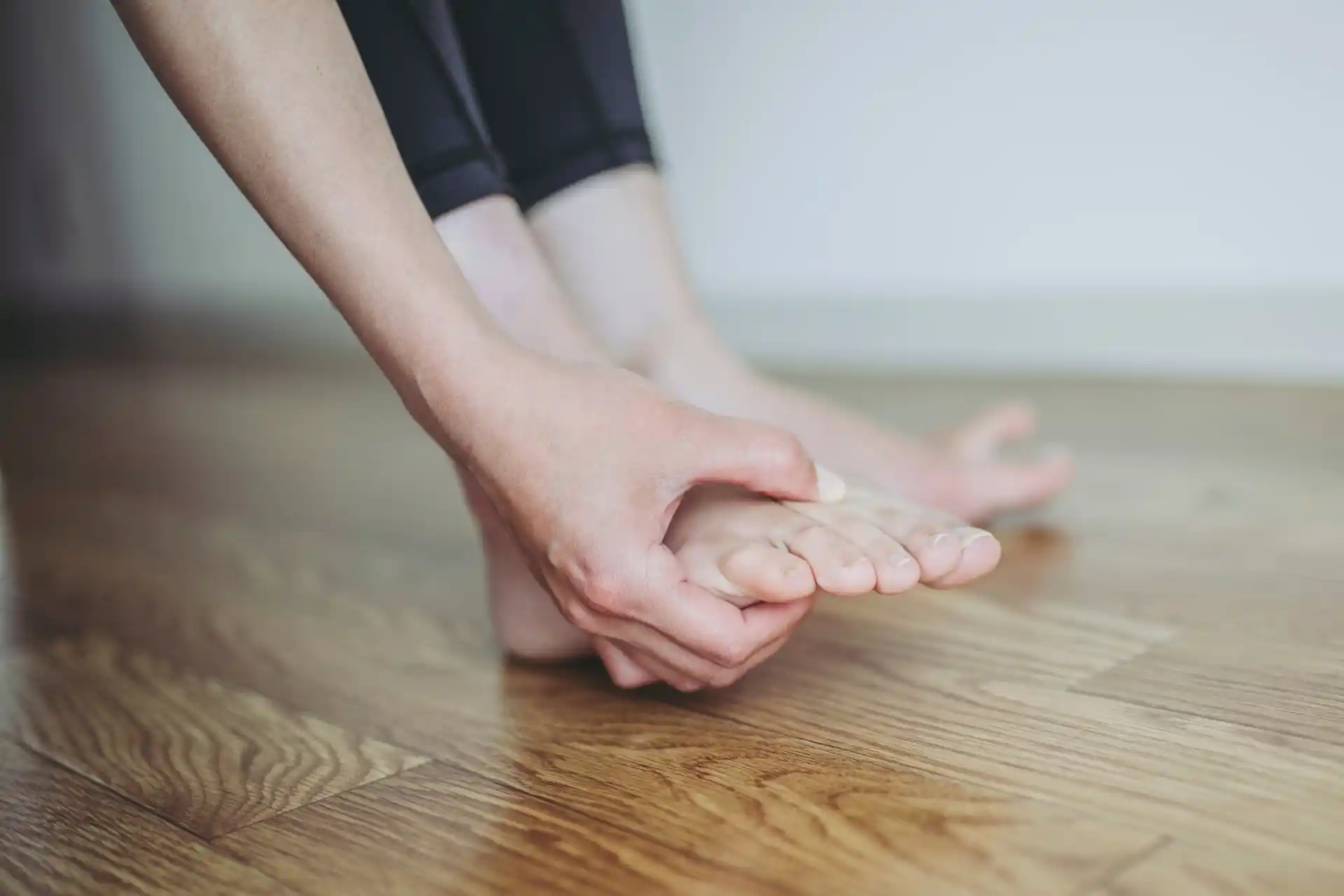Whether you first notice a strange pins-and-needles sensation during a long workday or after a casual walk, tingling in toes can feel unsettling.
You might wonder if it’s a harmless annoyance or a sign of something bigger. About 2.4% of the global population experiences some form of peripheral neuropathy, a broad term for nerve-related issues that often manifest as tingles, numbness, or pain in the feet.
The good news is, many causes of toe tingling can be managed with the right knowledge, practical steps, and a healthcare provider’s guidance.
Below, you’ll find an overview of why your toes might tingle, when to take action, and how to find relief.
We’ll look at common causes, helpful diagnostic tests, evidence-backed treatments, and everyday habits you can adopt to keep your feet feeling strong and comfortable.
Recognize The Early Clues
You may first notice tingling when you’ve been sitting or standing too long. This sensation often appears as a mild pins-and-needles feeling, but it can also present as:
- A buzzing or “electric shock” between the toes
- Brief numbness that fades, then recurs
- Burning pain on the top of your foot or near the toes
- Sensitivity to touch, temperature, or pressure
These symptoms can be surprisingly easy to overlook. You might chalk the feeling up to tired feet or tight shoes. Yet small signals in your toes can point to underlying issues elsewhere in your body.
A quick self-check is a good starting point. Notice when the tingles begin, how often they return, and what seems to trigger them—whether it’s a specific pair of shoes, a cold environment, or a certain time of day.
Jotting down a few notes can help you and your healthcare provider spot patterns and narrow down possible causes.
Understand Possible Causes
The reasons for tingling in your toes range from short-term irritation to chronic medical conditions. By understanding the most common culprits, you’ll be better prepared to address your discomfort and find a path to relief.
Mechanical Triggers: Shoes, Injuries, And Overuse
Something as simple as an ill-fitting shoe can pinch the nerves in your foot, prompting a tingling or numb sensation. Repetitive movements during a daily run can also inflame tendons or irritate nerve pathways.
Extensor tendonitis, for example, occurs when the tendons atop your foot become overused or injured, causing mild burning or tingling.
- Wearing tight shoes can squeeze nerves and worsen toe tingling.
- Repeated thick-sock-and-tight-boot combinations might restrict circulation.
- High-impact sports can stress your foot structures if done without proper support.
Metabolic Causes: Diabetes And Thyroid Issues
People with diabetes often develop diabetic neuropathy, a type of nerve damage caused by prolonged high blood sugar. Since your toes are the farthest parts of your body from your circulatory “hub,” they’re often the first place you’ll notice diabetic nerve trouble.
Hypothyroidism, an underactive thyroid, can also lead to sensations like numbness or tingles in the feet.
If you suspect your thyroid might be involved, a simple blood test measuring thyroid-stimulating hormone (TSH) can provide clarity.
Nerve Entrapments And Compression
Your tibial nerve, a major nerve running from the ankle into the foot, can become compressed in conditions like tarsal tunnel syndrome (TTS). According to Healthline, TTS can create a burning, tingling, or numb sensation that radiates into the toes. Sometimes, structural factors such as flat feet, varicose veins, or ankle injuries worsen compression.
If you suspect a trapped nerve, your doctor might use imaging scans or a nerve conduction study to investigate.
Other Underlying Conditions
Occasionally, toe tingling connects to more complex conditions. Multiple sclerosis (MS), an autoimmune disease targeting the central nervous system, can trigger numbness and tingling in limbs.
Kidney failure can also manifest as foot paresthesia (the medical term for tingling or prickling).
Additionally, certain hereditary conditions—like Charcot-Marie-Tooth disease—affect nerves and muscles in ways that may lead to persistent tingling.
Other conditions that might arise from nerve entrapment includes carpal tunnel syndrome, sciatica, and piriformis syndrome.
Explore Diagnosis Methods
To figure out what’s really causing your toe tingles, your doctor or podiatrist might use several diagnostic tools. Comprehensive testing ensures the correct root of your discomfort is found, allowing for treatments that truly help rather than just masking symptoms.
Physical Examination
A thorough foot exam can check for visible signs of injury or deformities. Your healthcare provider might assess blood flow in your toes by gently pressing on your nails to watch how quickly color returns. They’ll also see if certain motions provoke numbness or pain, which might point to a specific nerve entrapment or tendon inflammation.
Nerve Conduction Studies And EMG
Doctors often turn to nerve conduction studies and electromyography (EMG) to detect nerve damage.
A nerve conduction study measures how quickly and effectively electrical signals travel along your nerves, while EMG checks for muscle responses that might be sluggish or abnormal when nerves are compromised.
These tests shed light on whether you have peripheral neuropathy, as well as the severity of any nerve damage.
Imaging And Additional Tests
If structural issues are suspected—like tarsal tunnel syndrome or a foot deformity—an X-ray, ultrasound, or MRI can provide more detail.
Blood tests are valuable for diagnosing diabetes, thyroid problems, or vitamin deficiencies. In some cases, more specific tests (like a Tinel’s sign test for TTS) can pinpoint which nerve is irritated.
Try Relief Strategies
Once you know the cause, you can try effective strategies to ease that prickly toe sensation. Plenty of at-home measures can complement formal treatments, and most people combine both to get the best results.
Keep in mind that results tend to improve when you catch symptoms early.
Medication And Topical Treatments
If you have peripheral neuropathy, certain prescription medications can calm irritated nerves and reduce pain or tingling.
In some cases, you might use:
- Lidocaine creams or patches
- Antidepressants such as duloxetine or amitriptyline
- Anti-seizure medications prescribed for nerve pain
These might help if the tingling is severe or if it’s interfering with your daily life. Some people also explore topical herbal remedies or cannabis-based applications to reduce inflammation, as suggested by Healthline. Always ask your doctor before using supplements or herbal products to ensure they fit your health profile.
Warm Baths And Gentle Exercise
A warm bath is often a simple, effective way to soothe tired, tingling toes. The heat improves circulation, especially if you add Epsom or sea salt.
Regular exercise can further boost your body’s blood flow while helping maintain a healthy weight.
Activities like swimming, yoga, or cycling can reduce stress, lower blood sugar, and slow nerve damage.
The key is to start slowly, focus on gentle stretches, and progress gradually.
Lifestyle Tweaks And Foot Care
Even small changes in your everyday routine can have big impacts on nerve health:
- Check your footwear: Opt for shoes that offer enough room in the toe box and good arch support.
- Quit smoking if you can: Smoking restricts blood flow, which may worsen neuropathy symptoms.
- Keep an eye on injuries: If you have numbness in feet, you might not feel small cuts or burns until they become infections. Prompt foot self-checks are especially important for people with diabetes.
- Explore stress-relief methods like meditation: Lower stress levels can reduce the intensity of nerve-related pain.
Physical Therapy And Orthotics
A professional physical therapist can show you targeted exercises that encourage nerve recovery and relieve tension in foot muscles. They might recommend orthotics, special shoe inserts that redistribute pressure across your feet.
If your tingling stems from a condition like metatarsalgia (related to strain on the ball of your foot), custom orthotics can lessen the load on your nerves.
Other supportive measures, such as ankle braces, can help with tarsal tunnel syndrome when compression worsens.
Fascial Hydrodissection
This fluid-based treatment can release adhered fascia and soft tissue that can press on nerves—helping reduce tingling, burning, numbness, and pain associated with CRPS and other peripheral neuropathy conditions.1-7
Surgical Interventions
Surgery may be a last resort if conservative methods don’t bring relief. Doctors can sometimes free compressed nerves through procedures like nerve decompression, ensuring your foot tissues don’t continually pinch vital nerve pathways.
While most tingling responds well to less-invasive treatments, it’s useful to know that surgery is an option for stubborn cases.
When To Seek Help
Although occasional tingling that fades quickly isn’t usually cause for alarm, persistent or worsening symptoms warrant a professional opinion.
You should contact your healthcare provider if tingling persists, if it disrupts your daily tasks, or if it’s accompanied by muscle weakness or balance problems.
Untreated nerve issues can sometimes lead to more serious complications, from chronic pain to foot ulcers or infections.
Seek immediate attention if you suspect a stroke, transient ischemic attack, or severe nerve compression. Act quickly if your tingling is coupled with dizziness, severe headache, sudden numbness on one side of the body, or difficulty speaking.
Next Steps
Tingling in your toes often involves miscommunication within your peripheral nerves, triggered by factors like shoe pressure, diabetes, thyroid issues, or structural nerve entrapments.
Once you identify the specific cause, you can try strategies such as warm baths, foot-specific exercises, and topical treatments to find relief. It’s also wise to consider:
- Scheduling a nerve conduction or EMG test if tingling persists.
- Adjusting your lifestyle—quitting smoking, improving nutrition, and wearing comfortable shoes.
- Consulting your doctor about topical or prescription medications when tingling disrupts your routine.
Pick one of these steps and start today. If your toes feel better, it could be the first sign you’re on the right track.
Remember, a proactive approach often prevents further complications. And if you ever feel uncertain, you’re not alone—healthcare professionals can help you pinpoint what’s going on and show you a workable plan to keep your toes strong and steady.
Seek RELIEF®
RELIEF® is a science-backed treatment that targets dysfunctional fascia, which may contribute to nerve irritation and peripheral neuropathy.
Using a gentle technique called hydrodissection, RELIEF® releases adhered fascia and soft tissue that can press on nerves—helping reduce tingling, burning, numbness, and pain associated with nerve pain and other peripheral neuropathy conditions.1-7
RELIEF® is a minimally invasive alternative to traditional treatments and does not require steroids, long-term medication, surgery, anesthesia, or post-procedure immobilization.
If you’re in the Miami area and seeking relief from peripheral neuropathy, contact us today to schedule a consultation.


.jpg)

.jpg)

.svg)